History
When the B-26F-1 entered production in February 1944 with its revised wing incidence and internal improvements, it represented one of the last major Marauder variants. The B-26G followed as the final production model, with the most important change being the replacement of outdated Army Air Corps equipment with standardized Army-Navy (AN) gear, simplifying logistics and operations. The first B-26G-1-MA rolled out of Martin’s Middle River plant in Baltimore in March 1944.
Though externally almost identical to the B-26F-1, the B-26G was produced in eight different sub-blocks:
The B-26G-1-MA introduced the C-1 autopilot (at the request of the Ninth Air Force), standardized AN equipment, and adopted the Bell M-6A tail turret, previously fitted to RAF Marauder IIIs. A cross-feed fuel system was added, allowing either engine to draw from both wing tanks. A total of 100 were delivered to the Ninth Air Force in Britain beginning in mid-August 1944.
The B-26G-5-MA differed mainly in having a revised hydraulic system. 200 were produced and entered service with both the Ninth and Twelfth Air Forces. Many were also delivered to Free French units, though French crews generally disliked the G-model, considering it less stable and slower than the earlier B-26C-45-MO.
The B-26G-10-MA and G-11-MA introduced smaller refinements, such as a cartridge case collector for the tail guns, removal of the cowl flap lock valve, and, in some cases, Lycoming propellers. 125 G-10s were built for the USAAF, while 75 G-11s were delivered to the RAF, most sent to the Middle East but never assigned to operational squadrons.
The B-26G-15-MA removed the short-lived C-1 autopilot, with 140 examples produced. The B-26G-20-MA introduced a whip-type static discharger, otherwise identical to the G-15, with 60 built. Its RAF counterpart, the B-26G-21-MA, totaled 75 aircraft.
Finally, the B-26G-25-MA was the last production block of the Marauder line, incorporating only minor detail changes. 118 were built, including the final Marauder to roll off the Baltimore assembly line on April 18, 1945, marking the 5,266th and last B-26 produced.
By the end of the war, most USAAF Marauder units had converted to the faster, longer-ranged A-26 Invader or were disbanded outright. Only three groups remained in Europe for occupation duty, and the last active Marauder group was disbanded in early 1946. By the time the US Air Force was established in 1947, nearly all Marauders had been retired and scrapped, bringing the type’s service career to a close.








